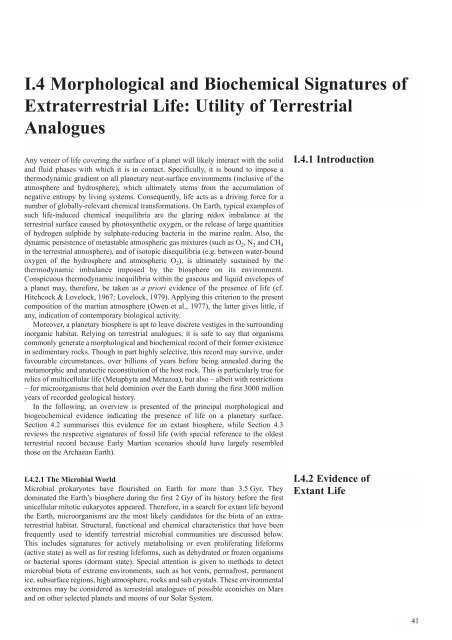Exobiology in the Solar System & The Search for Life on Mars - ESA
Exobiology in the Solar System & The Search for Life on Mars - ESA
Exobiology in the Solar System & The Search for Life on Mars - ESA
Create successful ePaper yourself
Turn your PDF publications into a flip-book with our unique Google optimized e-Paper software.
I.4 Morphological and Biochemical Signatures of<br />
Extraterrestrial <str<strong>on</strong>g>Life</str<strong>on</strong>g>: Utility of Terrestrial<br />
Analogues<br />
Any veneer of life cover<str<strong>on</strong>g>in</str<strong>on</strong>g>g <str<strong>on</strong>g>the</str<strong>on</strong>g> surface of a planet will likely <str<strong>on</strong>g>in</str<strong>on</strong>g>teract with <str<strong>on</strong>g>the</str<strong>on</strong>g> solid<br />
and fluid phases with which it is <str<strong>on</strong>g>in</str<strong>on</strong>g> c<strong>on</strong>tact. Specifically, it is bound to impose a<br />
<str<strong>on</strong>g>the</str<strong>on</strong>g>rmodynamic gradient <strong>on</strong> all planetary near-surface envir<strong>on</strong>ments (<str<strong>on</strong>g>in</str<strong>on</strong>g>clusive of <str<strong>on</strong>g>the</str<strong>on</strong>g><br />
atmosphere and hydrosphere), which ultimately stems from <str<strong>on</strong>g>the</str<strong>on</strong>g> accumulati<strong>on</strong> of<br />
negative entropy by liv<str<strong>on</strong>g>in</str<strong>on</strong>g>g systems. C<strong>on</strong>sequently, life acts as a driv<str<strong>on</strong>g>in</str<strong>on</strong>g>g <str<strong>on</strong>g>for</str<strong>on</strong>g>ce <str<strong>on</strong>g>for</str<strong>on</strong>g> a<br />
number of globally-relevant chemical trans<str<strong>on</strong>g>for</str<strong>on</strong>g>mati<strong>on</strong>s. On Earth, typical examples of<br />
such life-<str<strong>on</strong>g>in</str<strong>on</strong>g>duced chemical <str<strong>on</strong>g>in</str<strong>on</strong>g>equilibria are <str<strong>on</strong>g>the</str<strong>on</strong>g> glar<str<strong>on</strong>g>in</str<strong>on</strong>g>g redox imbalance at <str<strong>on</strong>g>the</str<strong>on</strong>g><br />
terrestrial surface caused by photosyn<str<strong>on</strong>g>the</str<strong>on</strong>g>tic oxygen, or <str<strong>on</strong>g>the</str<strong>on</strong>g> release of large quantities<br />
of hydrogen sulphide by sulphate-reduc<str<strong>on</strong>g>in</str<strong>on</strong>g>g bacteria <str<strong>on</strong>g>in</str<strong>on</strong>g> <str<strong>on</strong>g>the</str<strong>on</strong>g> mar<str<strong>on</strong>g>in</str<strong>on</strong>g>e realm. Also, <str<strong>on</strong>g>the</str<strong>on</strong>g><br />
dynamic persistence of metastable atmospheric gas mixtures (such as O 2, N 2 and CH 4<br />
<str<strong>on</strong>g>in</str<strong>on</strong>g> <str<strong>on</strong>g>the</str<strong>on</strong>g> terrestrial atmosphere), and of isotopic disequilibria (e.g. between water-bound<br />
oxygen of <str<strong>on</strong>g>the</str<strong>on</strong>g> hydrosphere and atmospheric O 2), is ultimately susta<str<strong>on</strong>g>in</str<strong>on</strong>g>ed by <str<strong>on</strong>g>the</str<strong>on</strong>g><br />
<str<strong>on</strong>g>the</str<strong>on</strong>g>rmodynamic imbalance imposed by <str<strong>on</strong>g>the</str<strong>on</strong>g> biosphere <strong>on</strong> its envir<strong>on</strong>ment.<br />
C<strong>on</strong>spicuous <str<strong>on</strong>g>the</str<strong>on</strong>g>rmodynamic <str<strong>on</strong>g>in</str<strong>on</strong>g>equilibria with<str<strong>on</strong>g>in</str<strong>on</strong>g> <str<strong>on</strong>g>the</str<strong>on</strong>g> gaseous and liquid envelopes of<br />
a planet may, <str<strong>on</strong>g>the</str<strong>on</strong>g>re<str<strong>on</strong>g>for</str<strong>on</strong>g>e, be taken as a priori evidence of <str<strong>on</strong>g>the</str<strong>on</strong>g> presence of life (cf.<br />
Hitchcock & Lovelock, 1967; Lovelock, 1979). Apply<str<strong>on</strong>g>in</str<strong>on</strong>g>g this criteri<strong>on</strong> to <str<strong>on</strong>g>the</str<strong>on</strong>g> present<br />
compositi<strong>on</strong> of <str<strong>on</strong>g>the</str<strong>on</strong>g> martian atmosphere (Owen et al., 1977), <str<strong>on</strong>g>the</str<strong>on</strong>g> latter gives little, if<br />
any, <str<strong>on</strong>g>in</str<strong>on</strong>g>dicati<strong>on</strong> of c<strong>on</strong>temporary biological activity.<br />
Moreover, a planetary biosphere is apt to leave discrete vestiges <str<strong>on</strong>g>in</str<strong>on</strong>g> <str<strong>on</strong>g>the</str<strong>on</strong>g> surround<str<strong>on</strong>g>in</str<strong>on</strong>g>g<br />
<str<strong>on</strong>g>in</str<strong>on</strong>g>organic habitat. Rely<str<strong>on</strong>g>in</str<strong>on</strong>g>g <strong>on</strong> terrestrial analogues, it is safe to say that organisms<br />
comm<strong>on</strong>ly generate a morphological and biochemical record of <str<strong>on</strong>g>the</str<strong>on</strong>g>ir <str<strong>on</strong>g>for</str<strong>on</strong>g>mer existence<br />
<str<strong>on</strong>g>in</str<strong>on</strong>g> sedimentary rocks. Though <str<strong>on</strong>g>in</str<strong>on</strong>g> part highly selective, this record may survive, under<br />
favourable circumstances, over billi<strong>on</strong>s of years be<str<strong>on</strong>g>for</str<strong>on</strong>g>e be<str<strong>on</strong>g>in</str<strong>on</strong>g>g annealed dur<str<strong>on</strong>g>in</str<strong>on</strong>g>g <str<strong>on</strong>g>the</str<strong>on</strong>g><br />
metamorphic and anatectic rec<strong>on</strong>stituti<strong>on</strong> of <str<strong>on</strong>g>the</str<strong>on</strong>g> host rock. This is particularly true <str<strong>on</strong>g>for</str<strong>on</strong>g><br />
relics of multicellular life (Metaphyta and Metazoa), but also – albeit with restricti<strong>on</strong>s<br />
– <str<strong>on</strong>g>for</str<strong>on</strong>g> microorganisms that held dom<str<strong>on</strong>g>in</str<strong>on</strong>g>i<strong>on</strong> over <str<strong>on</strong>g>the</str<strong>on</strong>g> Earth dur<str<strong>on</strong>g>in</str<strong>on</strong>g>g <str<strong>on</strong>g>the</str<strong>on</strong>g> first 3000 milli<strong>on</strong><br />
years of recorded geological history.<br />
In <str<strong>on</strong>g>the</str<strong>on</strong>g> follow<str<strong>on</strong>g>in</str<strong>on</strong>g>g, an overview is presented of <str<strong>on</strong>g>the</str<strong>on</strong>g> pr<str<strong>on</strong>g>in</str<strong>on</strong>g>cipal morphological and<br />
biogeochemical evidence <str<strong>on</strong>g>in</str<strong>on</strong>g>dicat<str<strong>on</strong>g>in</str<strong>on</strong>g>g <str<strong>on</strong>g>the</str<strong>on</strong>g> presence of life <strong>on</strong> a planetary surface.<br />
Secti<strong>on</strong> 4.2 summarises this evidence <str<strong>on</strong>g>for</str<strong>on</strong>g> an extant biosphere, while Secti<strong>on</strong> 4.3<br />
reviews <str<strong>on</strong>g>the</str<strong>on</strong>g> respective signatures of fossil life (with special reference to <str<strong>on</strong>g>the</str<strong>on</strong>g> oldest<br />
terrestrial record because Early Martian scenarios should have largely resembled<br />
those <strong>on</strong> <str<strong>on</strong>g>the</str<strong>on</strong>g> Archaean Earth).<br />
I.4.2.1 <str<strong>on</strong>g>The</str<strong>on</strong>g> Microbial World<br />
Microbial prokaryotes have flourished <strong>on</strong> Earth <str<strong>on</strong>g>for</str<strong>on</strong>g> more than 3.5 Gyr. <str<strong>on</strong>g>The</str<strong>on</strong>g>y<br />
dom<str<strong>on</strong>g>in</str<strong>on</strong>g>ated <str<strong>on</strong>g>the</str<strong>on</strong>g> Earth’s biosphere dur<str<strong>on</strong>g>in</str<strong>on</strong>g>g <str<strong>on</strong>g>the</str<strong>on</strong>g> first 2 Gyr of its history be<str<strong>on</strong>g>for</str<strong>on</strong>g>e <str<strong>on</strong>g>the</str<strong>on</strong>g> first<br />
unicellular mitotic eukaryotes appeared. <str<strong>on</strong>g>The</str<strong>on</strong>g>re<str<strong>on</strong>g>for</str<strong>on</strong>g>e, <str<strong>on</strong>g>in</str<strong>on</strong>g> a search <str<strong>on</strong>g>for</str<strong>on</strong>g> extant life bey<strong>on</strong>d<br />
<str<strong>on</strong>g>the</str<strong>on</strong>g> Earth, microorganisms are <str<strong>on</strong>g>the</str<strong>on</strong>g> most likely candidates <str<strong>on</strong>g>for</str<strong>on</strong>g> <str<strong>on</strong>g>the</str<strong>on</strong>g> biota of an extraterrestrial<br />
habitat. Structural, functi<strong>on</strong>al and chemical characteristics that have been<br />
frequently used to identify terrestrial microbial communities are discussed below.<br />
This <str<strong>on</strong>g>in</str<strong>on</strong>g>cludes signatures <str<strong>on</strong>g>for</str<strong>on</strong>g> actively metabolis<str<strong>on</strong>g>in</str<strong>on</strong>g>g or even proliferat<str<strong>on</strong>g>in</str<strong>on</strong>g>g life<str<strong>on</strong>g>for</str<strong>on</strong>g>ms<br />
(active state) as well as <str<strong>on</strong>g>for</str<strong>on</strong>g> rest<str<strong>on</strong>g>in</str<strong>on</strong>g>g life<str<strong>on</strong>g>for</str<strong>on</strong>g>ms, such as dehydrated or frozen organisms<br />
or bacterial spores (dormant state). Special attenti<strong>on</strong> is given to methods to detect<br />
microbial biota of extreme envir<strong>on</strong>ments, such as hot vents, permafrost, permanent<br />
ice, subsurface regi<strong>on</strong>s, high atmosphere, rocks and salt crystals. <str<strong>on</strong>g>The</str<strong>on</strong>g>se envir<strong>on</strong>mental<br />
extremes may be c<strong>on</strong>sidered as terrestrial analogues of possible ec<strong>on</strong>iches <strong>on</strong> <strong>Mars</strong><br />
and <strong>on</strong> o<str<strong>on</strong>g>the</str<strong>on</strong>g>r selected planets and mo<strong>on</strong>s of our <str<strong>on</strong>g>Solar</str<strong>on</strong>g> <str<strong>on</strong>g>System</str<strong>on</strong>g>.<br />
I.4.1 Introducti<strong>on</strong><br />
I.4.2 Evidence of<br />
Extant <str<strong>on</strong>g>Life</str<strong>on</strong>g><br />
41

















